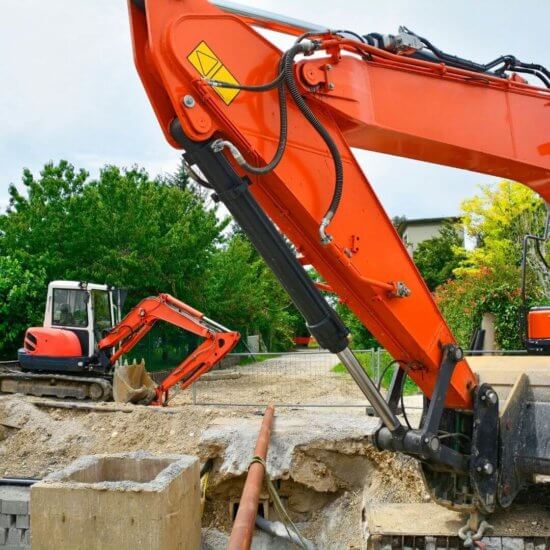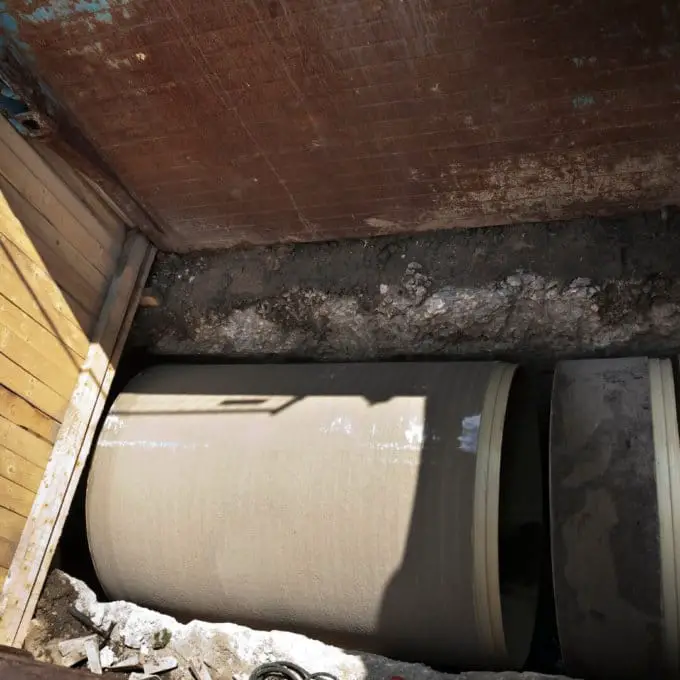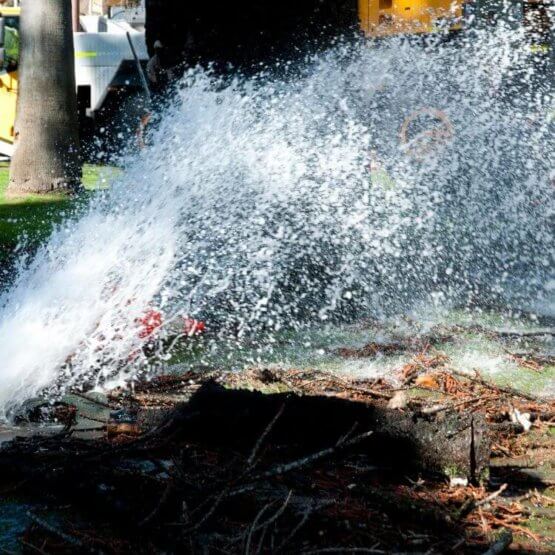No one looks forward to digging up the entire yard in order to fix a faulty sewer line. A trenchless pipe repair system exists as a solution to that.
This method is a perfect alternative to the traditional sewer line repair process. Traditional repairs need to raise a large amount of foundation, which damages your garden and surrounding areas.
In contrast, a trenchless method allows for a non-invasive way to inspect and repair your pipes. It won’t disturb any landscaping but is equally as effective.
Trenchless pipe repair is a method to be used in order to either replace a part of faulty piping or help identify the clogged areas.
To learn more about when and how a trenchless system is applied, continue reading this article.
Trenchless Pipe Repair

Relatively new technology in the plumbing world called trenchless pipe repair presents a new way of sewer pipe replacement.
A more traditional sewer line repair requires professionals to dig up your yard in order to repair the pipeline.
This implies that they had to tear up your lawn by lifting up large chunks of foundation to get to the pipeline. This would also kill some trees, destroy gardens, and sometimes even pathways or driveways.
These types of traditional sewer line repairs typically entailed the use of large machines and other types of special equipment. These are required in order to lift up the land and replace the sewer line from the house to the street.
The trenched pipe repair allowed for repairing some severe damages, which is still the main advantage of this method. However, the disadvantages are huge, considering the amount of damage it can cause to the surrounding area.
On the other hand, trenchless pipe repairs allow us to replace sewer line systems with little to no impact on the land. They usually entail just one or two holes, which are still way smaller than the ones needed for a traditional method.
Also, there is more than one way to do trenchless pipe repair. To discuss trenchless sewer pipe repair more deeply, we need to look at the pros and cons of this system.
Trenchless Sewer Repair Pros and Cons
Below are the pros & cons of trenchless pipe repair compared to traditional pipe repair.
Pros of Trenchless Pipe Repair
- Faster repair – Trenchless pipe repair can be done within a day. Because the traditional method requires more digging, the trenchless system is usually a way faster option.
- Less digging – As the name itself states, the trenchless method requires less work overall, which also means fewer consequences to the property.
- Less possible damage – As you only need one or two holes in order to do this method, there is less possible damage caused to the surrounding area.
- Eco-friendly – Not only is there less damage with the trenchless method, but the equipment used causes less harm to the environment.
- Special equipment – The equipment of premium quality is used during the trenchless method. It requires a special camera snaked through the hole to help identify and repair the damage on the pipeline.
- It’s cheaper – To be fair, this is not always the case. However, when you add up all costs of a traditional repair, a trenchless one tends to be quicker and last longer.
- Longevity – The trenchless pipe repair method repair your pipes with resin pipes, which can last up to fifty years. This enables you to save money in the long term while causing minimal short-term damage.
Cons of Trenchless Pipe Repair
- Not always possible – Unfortunately, performing trenchless pipe repair is not always feasible. It’s possible to perform this method only for minor pipe damage or burst pipes.
However, if your sewer line system is about 40-50 years old, it might be a time for a complete replacement. Also, some severe pipeline damages are not solvable by the use of a trenchless system.
- Higher initial costs – This may sound contradictory at first, but it’s not. The trenchless method might have higher initial costs, which is sometimes considered a con.
In spite of that, it’s still cheaper when you add up all costs needed to repair the landscape after using the traditional method. That being said, even with higher initial costs, with the trenchless methods, you save money in the long run.
Signs You Need a Trenchless Pipe Repair
Let’s look at the signs that a trenchless pipe repair is needed. This should further help you decide if this method is the appropriate one for your situation.
Oftentimes, these signs will mean that your sewer line is blocked or clogged partially. Other times, you may have a burst pipe on your hands.
Signs a trenchless pipe repair is needed may include:
- Slow Draining – One of the first signs of a clogged sewer line is slow draining. If you notice only one of your sinks in the house draining slowly, then it might be the case of a clogged sink only.
However, noticing that all of the water used in your house drains slower and slower might be an indication of a larger problem. This usually indicates a clogged sewer line or tree roots in the sewer pipes.
- Foul Smells – What you also might be able to notice are sewage smells outside the house or coming from the sinks.
These foul smells might be coming from the yard as well, which happens when there is a sewer pipe leak. You might also notice water backing up in your house, accompanied by gurgling sounds.
- Sudden Greenery – If you notice a sudden green patch in your yard, this may indicate a sewer pipe leak. Even though the sewer lines are buried deep into the ground, leaking sewage serves as a great fertilizer for the plants.
Trenchless Pipe Repair Equipment

As mentioned previously, trenchless pipe repair systems involve the use of more advanced equipment of premium quality.
It is, in fact, this equipment that makes this process initially more expensive than the traditional excavation.
That being said, the following equipment will be useful for anyone with more experience or for repair companies.
- Video Camera
A proper camera is exactly what makes trenchless pipe repair possible and more convenient. This non-invasive camera is pulled through the pipe to inspect the problem.
This camera helps you identify the exact problem, the width and length of the pipe, and the amount of resin needed.
- Epoxy Resin
Resin is used to form the new pipeline inside the existing, faulty one. The way this works is with liquid resin hardening up on the pipelining, creating a new pipeline. [2]
It’s very important to invest in quality resin products in order to ensure the durability of your pipes.
- Hydraulic Pumps
The need for the hydraulic pump will depend on the type of trenchless repair process you choose. Usually, hydraulic pumps are used during pipe bursting in order to speed up the process. [3]
- Pipe Liners or Pulling Units
Also, depending on the type of trenchless method, you will either need pipe liners or pulling units.
Pipeliners are used during the pipe lining process, where they serve as an internal lining in the existing piping system. [4]
Pulling units are used in pipe bursting in order to burst the old pipes and prepare them for replacement.
Types of Trenchless Pipe Repair Methods

When it comes to the types of trenchless pipe repair processes, these have grown in number during recent years. Overall, there are two main types of trenchless pipe repairs: pipe lining and pipe bursting.
As you will notice, a trenchless pipe repair system requires little to no digging, which is the purpose of this method.
Pipe Lining
Pipelining is an effective zero dig trenchless pipe repair option.
A thin layer of pipe liner is used in the interior of the existing pipeline. Whenever there is a crack on the existing sewer line, the sewage spills out on your property.
By inserting the flexible pipe liner into the pipe, a plumber is able to cover or mask the existing holes in the pipe. Initially, the pipelining is soft and flexible, which allows it to cover the inner part of the pipeline.
However, after being covered with resin, a pipe liner hardens and creates a water-tight seal. It goes without saying, but this type of seal is necessary and important in sewer lines.
By the use of a winch tool, the pipe liner is pulled through the existing sewer line. After that, it’s inflated and set in place.
After it hardens, a pipe liner is able to cover all of the cracks and stop the existing leaks in the pipeline.
It shouldn’t worry you that a pipe liner is thin and flexible. Pipeliners are very durable once they dry and, with adequate installation, can last even up to 50 years!
Also, it shouldn’t worry you that the pipe liner takes up the space within the existing pipeline. This is expected and a usual part of the process.
In fact, the pipe liners are so thin that they have no impact on your pipeline capacity whatsoever.
This method is a perfect choice for anyone looking to seal some cracks here and there before they become a larger problem.
However, do keep in mind that simply pulling a pipe liner inside a severely damaged pipeline won’t help that much. Situations with more complex problems usually do require digging and pipe replacement.
Pipe Bursting

A pipe bursting method is another method of trenchless pipe repair. It requires bursting an existing pipe outward by the use of a bursting tool or winch. [5]
This way, a part of the existing sewer line is destroyed.
It’s worth mentioning that this method does leave a hole in the ground. The hole remains where the previous line was.
By destroying the existing pipeline, a winch tool also simultaneously replaces it with a new pipeline. It can do so because the new pipeline is attached to the bursting head.
This new pipeline is attached once the winch tool completes replacing the old pipeline.
By simultaneously destroying the old pipeline and replacing it with a new one, a pipe bursting process is faster than the pipelining.
In contrast to pipelining, pipe bursting can be used to repair more severely damaged pipes. This is because the old pipeline, which you don’t intend to use, is destroyed, not masked.
However, do keep in mind that the pipe bursting still has its limits as a method. You can’t use pipe bursting in order to replace a whole pipeline or improve its poor structure.
Research how long do clay sewer pipes last and about putting a 90-degree turn in sewer lines to know your options.
Trenchless Pipe Repair Cost
Trenchless pipe repair can cost you anywhere from $80 to $290 per linear foot of pipe. On average, repairing the pipeline with a trenchless method costs about $170 per foot.
This is, of course, if you decide to call professionals for a trenchless pipe repair.
As you can see in this article, a trenchless method really entails the use of some high-end and complex tools.
Just because it doesn’t require digging doesn’t mean it’s safe for anyone to do. It requires bursting open the pipes, as well as knowing how to properly insert the new pipelining.
Although some think that a DIY trenchless pipe repair is possible, we recommend you rather phone a professional.
If you happen to be a skillful plumber, then you can try and do this method yourself. Just make sure to check out the local building codes in case they affect your sewage system.
Conclusion
Overall, a trenchless pipe repair process can be done in one of two ways.
One way to use this method is to mask the interior of the existing sewer line by the use of pipe liners. The other way is to burst the existing pipe open and replace it with pipe liners with the use of a special tool.
Both ways are equally as efficient and serve as a great alternative to more invasive methods. With a trenchless system, your landscape will stay intact and your pipeline repaired.

Michael Davis is a heating & plumbing expert who currently works as independent contractor in SC. He also writes for Plumbertip.
For almost 10 years he worked on various plumbing tasks across South Carolina.



